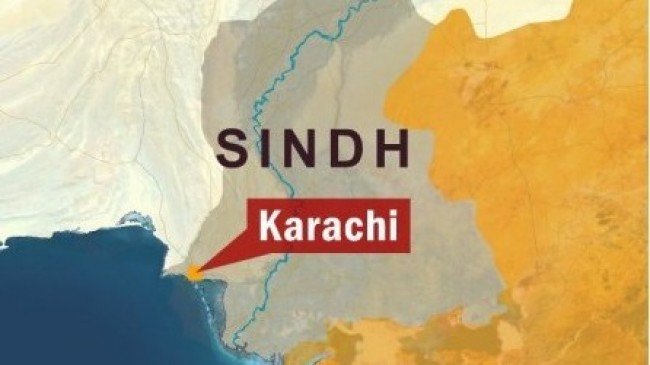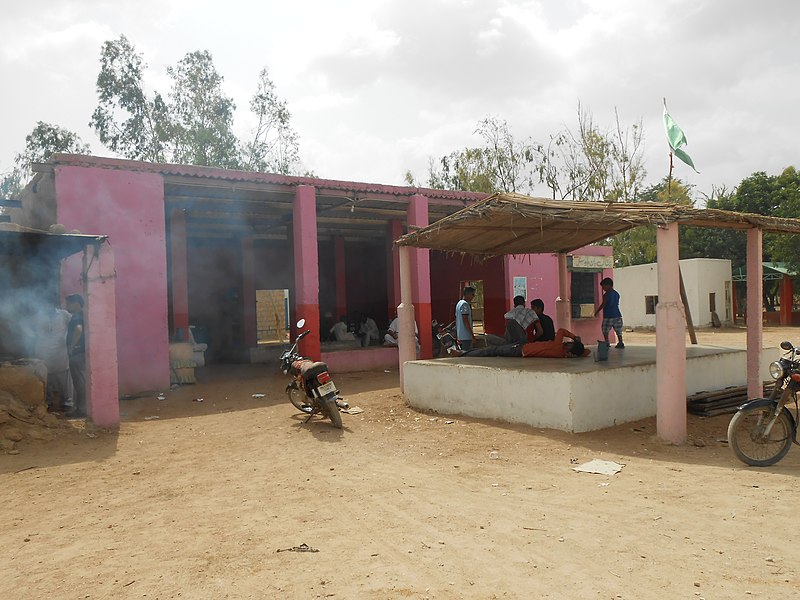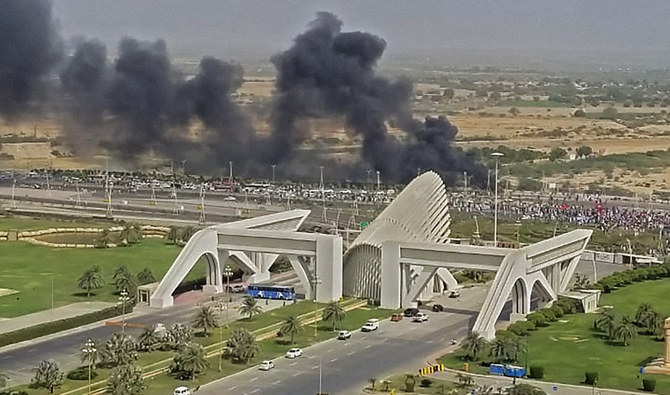
[From imperial ‘unhappy valley’, to decapitated province, commercial capital, and 21st century megacity, this article reflects on relations of separateness and connectivity between Sindh and its capital city Karachi. These culminated in Pakistan’s post-Independence years, in official and political language, governances of national, provincial and city division, and political rhetoric and violence. The article asks what else might be uncovered about their relationship other than customary alignments and partitions between an alien urban behemoth and a provincial periphery. It develops a topographical view to refer to the physical arrangement of environments but also people’s profane, spiritual and political connections and losses involving place and dwelling]
By Nichola Khan
Swell and ebb
Karim (2018) estimates around 8 million people missing from the 2018 census figures for Sindh, and 5 million uncounted in Karachi. Given the census informs public funds allocations, he is deeply critical of Karachi’s cited decline in population growth, from 3.5% annual growth in the 1990s to 2.5% during 1998–2017 (a figure also disputed by the Sindh government) compared with a doubling of Lahore’s population during the same period.

In the lacuna of unanswered questions around census data, Hasan highlights substantial recent migrations of Sindhi-speakers into Karachi, and estimates around 12% Karachi citizens are now Sindhi speaking (Aug. 2018, personal correspondence). Sindhi speakers work in the fishing industry, in coastal villages, or the Gadap and Malir oasis as farmers; as middlemen in Karachi’s wholesale markets, white-collar workers, bankers, bureaucrats, estate and travel agents; as students and doctors in Karachi hospitals. Sindhi poetry recitals, music, drama, book launches, and television plays, all produced in Karachi, occur regularly; Sindhi involvement in non-Sindhi events is familiar. The children of rich waderas (landowners) are ‘Karachiized’. ‘Simple’, contends Hasan. ‘Sindhis are reclaiming their city after seventy years of Punjabi and Mohajir colonization’. Hasan’s optimism about middle-class Sindhi reclamation of native land downplays his own and others’ work on the loss of Sindhi pastoralist and village life at Karachi’s Western edges, and the forced disappearance of around 3000 goths (villages) of predominantly Sindhi and Baloch agro-livestock and pastoralist communities in the past two decades (Anwar, 2014; Hasan, 2015). Most peri-urban settlements here occupy uncultivated, state-owned land which colonial custom had made accessible for tenants’ (migrants, workers) homesteads (Anwar, 2018).
Cons (2016: 13) emphasized the permeability of India–Bangladesh borders in order to reflect on ‘questions of migration, terrorism, trade and security’. His concepts of anxious territory and elastic lands refer to the ‘strategic expansion and contraction’ of property boundaries, and legal and political regimes of governance that are continually reformatted and destabilized. These bear aptly on the regulation and expansion of the Sindh-Karachi border-zone where, despite existing land acts designed to protect the destruction of informal settlements, quasi-legal and outright illegal land acquisitions are catalyzing the rapid construction of mega-residential enclaves, infrastructural, luxury and commercial projects, gated communities, luxury housing estates for overseas Pakistanis, education cities, and shopping complexes. These utopian visions are permeated with anxieties about security.
Relatedly, Anwar (2018) explores receding rurality and economic power and value struggles over Karachi’s peripheral lands, and unpicks complex relationships between law, land, municipal governance and closely interwoven legacies of pre-colonial and colonial property-relations in the ‘booming periphery’ of the city’s changing agrarian–urban frontier. She argues that much of this contemporary spatial ‘fix’ unfolds in the realm of informality wherein the state enables ‘zones of exception’, for example Defence Housing Authority City and Bahria Town Karachi (BTK), by creating special benefits for corporate investors and the military by suspending laws, altering land use, or acquiring land forcibly (49). For example, the BTK development was enabled by real-estate tycoon Malik Riaz’s long-standing partnership with the Pakistan navy. This ‘illegal’ process of land acquisitions that enables projects like the BTK is hardly external to the domain of law but constituted, Anwar argues, by the very basis of state authority and withdrawal of state regulatory power regarding land. Unsurprisingly, the public–private partnerships undergirding the transformation of rural lands into profitable urban real-estate developments did not profit small-scale farmers, sharecroppers and pastoralists, but rather diverse state and private actors including developers, politicians, the police, brokers and waderas themselves.
The incorporation of traditional hinterlands into Karachi’s official contours, and the expansion of a ‘world class’ city that is clean, safe, and erased of the poor has increased expulsions, displacements, and community protests. It exemplifies wider processes of ‘slum-free’ urbanization in South Asia that are driven by projects of postcolonial governance and power between Asia and the USA, in the penumbra of European empires (Roy, 2014). After decentralization in 2001 and US economic sanctions were lifted in Pakistan, Karachi’s landscape was remapped. Sindhi, Baloch, and Mohajir actors now co-operated around the incorporation of rural land into highly lucrative urban real estate development. Karachi’s urban renewal mirrored the revitalization of the national economy. In 2007, the city mayor, Mustafa Kamal, of the Mohajir’s Muttahida Quami Movement (MQM) party, propelled the Karachi Strategic Development Plan 2020 (Hasan, 2015). This precipitated a growth in the property market of 255% for 2011–2016 (Express Tribune, 2016). In 2013, the China–Pakistan Economic Corridor (CPEC) was launched with a predicted value of USD59 billion to come from myriad infrastructure projects, over a million new jobs in Pakistan, and economic growth produced by connectivity between China, Central Asian states, Iran, Turkey, Russia, and Europe: Gwadar port in Balochistan would facilitate trade with neighboring countries through ‘special economic zones’ (Ashraf, 2017).
The consequences of the conflux of state, private, political and individual enterprise in Karachi’s land and development economy were demolitions of entire villages and informal katchi abadi settlements, manifold court cases, and the opposition of land rights and activist movements (Hasan, 2015). Community opposition to the demolition of formal settlements along the Lyari river to build an expressway resulted in protracted court-cases (Siddiqui, 2013), defaults on Chinese loan repayments, violence against Chinese laborers, empty buildings, and idle machinery. These displacements are interlaced with multiple layered memories of forced relocations, dispersals, and the disappearances of activists, journalists, and communities through decades of military operations: repressions which crushed people’s spirit and pushed them ‘underground’, into new neighborhoods, and situations of subterraneity, semi-legality, and restriction.
If the map is the visual elaboration of a historical loss, break, and an exile, it is also a utopian capitalist vision driven by accumulation by dispossession. Unlike the studious recording of the displacements of Partition, one effect of dismantling and expanding Karachi’s skylines is to leave the contemporary pathways of dispossessed people comparatively uncharted. Unforgotten, these human erasures become enfolded into the contours of stories and myths that overflow messily into other knowledges. Sacrificed to the city’s expansion, the goth with its winding gulleys, deep earth, and dark passages, must relinquish its dwellings to memory and demolition for a new urban village that will erase all traces of violence from its plans for new dwelling and life.
Soil and separatism
The migration of those who crossed the Indian borders for Karachi also belongs to the Islamic idiom of the hijra which, as a departure from oneself and one’s place, also comprises a devotional journey without possibility of return. It shapes the post-Independence story of both Mohajirs and Sindhis.
In brief, the history of the Mohajirs’ rise in the 1940s and 1950s, their relative loss of status by the 1970s and the ‘Punjabization’ of Pakistan’s civil and political institutions and the rise of Mohajir and Sindhi nationalisms in Sindh is well documented. In the 1970s, Sindhi-Mohajir tensions culminated in riots over Bhutto’s Sindh Language Bill which forced Mohajirs to speak Sindhi in parliament and at work. Sindhis embraced an ‘indigenous revival’ of Sufism and mysticism that innovated around Islamic nationalism, ethnicity, and social justice (Verkaaik, 2004). Mohajir grievances pivoted around their disadvantages following the 1973 quota system in public sector employment, implemented in Sindh only. The nomer Mohajir became articulated as Pakistan’s ‘fifth ethnicity’ in the MQM party, founded in 1984 by Altaf Hussain. In a combative dance of mimetic escalation, antagonistic Sindhi and Mohajir nationalisms subsequently crystallized around the idioms of language, soil, and indigeneity.
Young MQM militants mobilized to arms across their neighborhoods around opposition to the state, their traditional Islamist parties, and Partition in a total ‘war’ that dominated Karachi c. 1984–2002, forcing Sindhi grievances backstage. Karachi’s post-Partition communities of settlement became armed politically-affiliated enclaves, ‘sensitive spaces’ shaped by anxieties ‘that undergird territorial rule…. the control of space, and nationalist imaginations of territory as “blood and soil”’ (Cons, 2016: 7). Simultaneously, many parties feuding over land, political, and economic power traded weapons. MQM and Islamist militants fought across Karachi, but in their neighborhoods spoke the same language, had been childhood friends, and co-existed amicably (Khan, 2012). Their urban encounters, amiable and violent interactions, and tacit evasions contradict the fiction that identities derived from territorial borders between insider and other, identity and hostility, ‘Islamist’ and ‘secular’, necessarily translate in reality. They urge fresh readings of the postcolonial urban through a deeper mining of quotidian neighborhood life.
Sindhi nationalism began in the 1930s in colonial campaigns for separation from the Bombay Presidency. It re-emerged in the 1950s and culminated in support for G.M. Syed’s demands for a separate Sindhudesh which would establish the boundaries of Sindhi rights to the land and self-determination, halt the Sindh’s incorporation by the Punjabist state, the influx of hostile outsiders, and the erosion of Sindhi culture and language. After Bangladesh’s Independence (1971), Syed reconstituted the Jiye Sindh Mahaz (JSM), advocating for Sindh’s secession from Pakistan, a separate Sindhudesh, and the expulsion of all non-Sindhis from land granted to them, including the return of the Mohajirs to India (Syed, 1985). After Syed’s death in 1995, the separatist Jeay Sindh Qaumi Mahaz (JSQM) emerged. Correspondingly, the elusive map of Jinnahpur appeared, demarcating a separate Mohajir state in Sindh. Notwithstanding, in the 1980s the JSM and MQM entered short-lived alliances. Karachi saw slogans of ‘Syed-Altaf-Bhai-Bhai’ and ‘Sindhi-Mohajir-Bhai-Bhai’ raised at MQM rallies, and Syed’s birthday was celebrated annually by MQM (Korejo, 2002). Hussain’s poem Sindh Kay Basiyon Key Naam (Dedicated to the People of Sindh, n.d.) pleads Sindhis to accept the Mohajirs as fellow Sindhis, using the symbols of a Sufistic tradition.

Amidst the ethnic violence accompanying the end of General Zia’s military dictatorship (1988) a groundswell of support for the Sindhudesh movement rallied; likewise, in 2007 after Benazir Bhutto’s assassination in marches across Karachi; and in 2012, 2014 and 2017 (Business Standard News, 2017). Sindhi nationalist and separatist grievances now centre on the state’s security forces’ attempts to ban secular political organizations, depoliticize Sindhi rights to language, land, and freedom of expression; and its abduction, imprisonment, torture, and killing of secular nationalists, while simultaneously sponsoring a network of jihadist madrassas across Sindh. These struggles are strongly supported by the Sindhi diaspora, Hindu Sindhis, and the global World Sindhi Congress movement.
Sindh nationalist and separatism also re-adopted militant forms: in the political wing of the Sindhu Desh Liberation army (banned in 2013), and the Jeay Sindh Muttahida Mahaz. Encouraged by the insurgency in Balochistan, groups mobilized around the arrests, intimidation, and killings of Sindhi nationalists by the security forces; in response, intelligence officials facilitated violent extremist organizations in upper Sindh in attempts to counter Sindhi nationalist groups (Yusuf and Hasan, 2015).
If political coalitions failed, and Mohajirs killed Sindhis and vice versa on grounds of irreconcilable difference, the ‘seepage’ of bodies (Cons, 2017) through the boundaries of urban realities helps to re-conceptualize topographical notions of identity as bordered, bodied, and mobile. Neither Sindhudesh, which includes Karachi and major centers of urban Sindh, nor Jinnahpur, have offered solutions for reconciling urban mega-diversity with their separatist visions. Furthermore, Bhitshah and other centers of Sindhi culture are now fully globally connected. While many of Bhitshah’s professionalized residents have migrated to Karachi, Europe, and America, many devotees around the world travel the National Highway from Karachi to visit Shah Abdul Latif’s shrine: during the annual Urs commemoration, the refurbished shrine is full with visitors, musicians, poets, and worshippers (Ahmed, 2015). In pushing against the tide of bodies moving across old border-zones, and the de-territorialized flows of free-market ideologies propelling new ebbs and flows of human and economic capital, separatist visions with their uncompromising borders of territory and identity appear anachronistic, in need of new formulations. (Continues)
__________________
About the Author
Nichola Khan is a Reader in Anthropology and Psychology, and Director of the Centre for Research in Spatial, Environmental and Cultural Politics at the University of Brighton. She is author of the following books: Mohajir Militancy in Pakistan (2010, Routledge), Cityscapes of Violence in Karachi (ed., 2017 Hurst & Co.,) Mental Disorder: Anthropological Insights (2017, University of Toronto Press) and Arc of the Journeyman: Afghan Migrants in England (in press, University of Minnesota Press). She is currently developing a literary anthropological project on war and migration in twentieth-century Chinese South-East Asia.
Click here for Part-I , Part-II